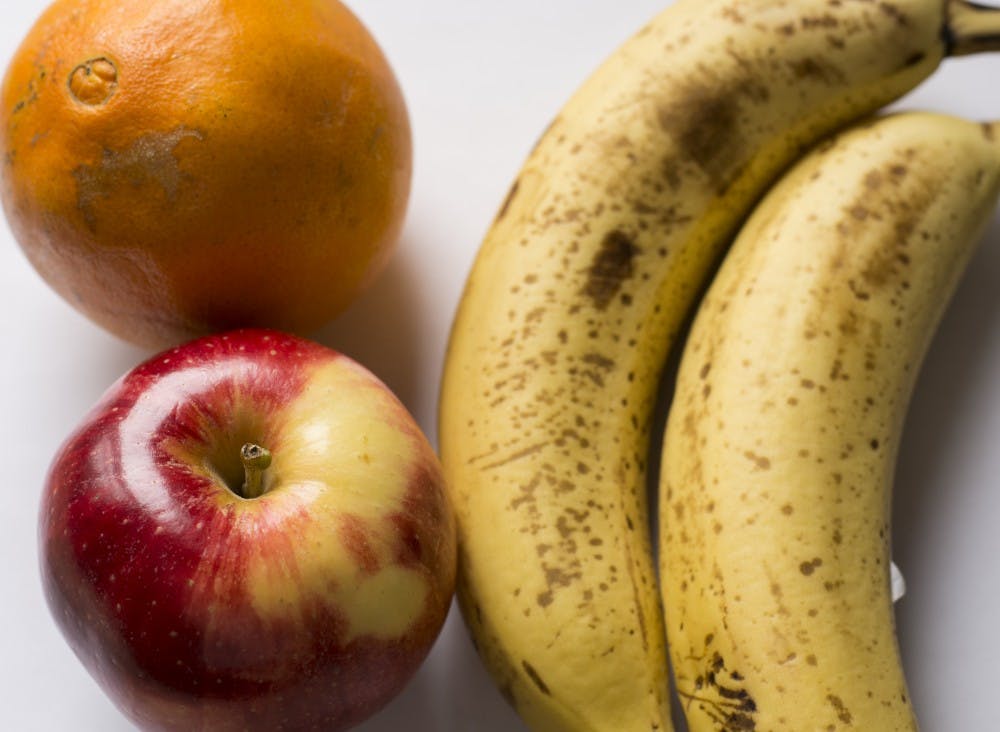When two freshmen created a petition for more fresh fruits and vegetables in the dining halls across campus, they didn't intend to criticize Ball State’s current menu options.
The petition, created by roommates Selena Webb and Lexi Benakovich orchestrated on Feb. 3, 2016, was a challenge to the university to provide students and faculty with an even wider selection of food choices.
Their efforts also contribute to Ball State’s sustainability efforts, as eating less meat helps reduce a person’s and institution’s carbon footprint, according to a study published in Environmental Research Letters. Some students are more aware this month because of Earth Day on April 22.
“If you eat better, you feel better,” Webb said. “If you feel better, you perform better. … I just want to make Ball State healthier and give more options to people.”
Benakovich, a member of the Residence Hall Association, said the idea for the petition originated when Student Government Association Senator Jake Peterson asked her opinion on how to improve campus.
For Benakovich, the answer to expand students’ fresh food choices was routine.
In high school, she had dedicated herself to healthy eating challenges. Her mom provided the groceries, which would always include a variety of fresh produce.
“It was more natural to me to think of that because it is something I do,” she said. “From what I had come from, I thought it would be a good idea to add more of a variety for people.”
Benakovich said the petition received a school record 327 signatures in three hours. The Student Government Association did not pass the bill, however, due to miscommunication and what Webb called “political jargon” concerning certain words and phrases.
Despite the petition not coming to fruition, members of Dining Services met with a SGA representative to discuss the students’ desires.
Lucas Miller, an assistant director of operation and executive chef at Ball State, said the result of the meeting is the recent additions of whole fresh fruits and vegetables in several locations on campus, including Woodworth, Noyer and the Atrium in the Art and Journalism Building.
“The conversation [with SGA] brought awareness of the fact that students wanted more vegetables, which is something that [Dining Services] didn’t really think that students would,” Miller said. “We appreciate it. We do everything we think we can to understand what students want, but, in the end, it really helps us to have students communicate to us what their wants and needs are.”
While Ball State should not be held responsible for what students choose to eat, a wider array of fresh fruits and vegetables could inspire healthier diets — a lifestyle choice that many Americans fail to prioritize.
The Centers for Disease Control and Prevention released a report in July 2015 indicating 87 percent of Americans fail to meet the United States Department of Agriculture’s minimum recommended daily amount of fruit. Ninety-one percent don’t consume enough vegetables.
American adults served as the focus of the report, but the nation’s college students aren’t faring much better.
The American College Health Association found in its latest National College Health Assessment only 6.5 percent of students reach the recommended five servings of fruits and vegetables combined on a daily basis.
The importance of eating healthy
Christy Tunnell teaches nutrition and dietetics at Ball State and also serves as the president of the Indiana Academy of Nutrition and Dietetics.
Tunnell said when most people come to college they are generally around the age of 18, and their bodies are not done developing. Studies show the human brain can develop up to age 25 on average.
“You may still have [students] who are going through growth spurts,” Tunnell said. “For females, … they may be finishing up some of the things that their body does to prepare them for childbearing. Anytime anyone is in a state of development, you need to have proper nutrition.”
Austin Dossey serves as the nutrition program coordinator at Lifetime Fitness in Indianapolis.
Dossey said food choices can play key factors in physical health. One system in the body that food choice heavily influences is digestion, which houses 75 percent of all the body’s neurotransmitters — the drivers of brain function and emotions.
“Experts say 80 percent of all chronic diseases can be prevented through proper nutrition and exercise,” Dossey said. “Type II diabetes is nearly 100 percent preventable through diet and exercise. Statistically, three out of four people with diabetes die of heart attack or stroke — totally preventable.”
In the classroom, Tunnell often hears from students that the reason they don’t eat enough fruits and vegetables is because of the expense. Single pieces of fruit usually cost between 75 cents to $1.25 on campus. To get the recommended daily serving, which is two to three pieces of fruit or two cups of fruit, students would need to spend about $2.50 per day on fruit.
Ball State students are allotted $4.65 for breakfast, $8.20 for lunch and another $8.20 for dinner with their meal plan.
The school’s vegetable options aren’t as numerous and are also a little more expensive. A 6-ounce veggie cup costs $2.50, or about 30 percent of a student’s lunch and dinner swipes on one item. To get the recommended daily intake of vegetables, which is three to four servings, students would need to spend about $5 to $7.50 per day.
If a food group or two has to be excluded for some reason from one’s diet, it shouldn’t be fruits and veggies, Tunell said. The most nutritious foods are fruits, vegetables and whole grains, and incorporating these groups into one’s diet can help with stress.
“College students are under a lot of stress,” Tunnell said. “Anytime any human body is stressed out, nutrition becomes extremely important. Your body relies on the nutrients you take in to be able to counteract stress reactions.”
In Dossey’s opinion, a mindful exercise and nutritional program can even save one’s life.
“I had a client’s husband die of a massive heart attack while driving in his car, while his wife and kids were in it,” he said. “These things have real-life consequences that many people ignore.”
Environmental benefits of eating less meat
Quinn Hurley, a sophomore, creative writing major, became a full-fledged vegetarian August 2015 after three years of a pescetarian diet, which excludes any land animals or birds from the diet but allows fish and other seafood, as well as vegetarian foods, such as beans, grains and nuts, in addition to fruits and vegetables.
Hurley decided to cut fish and seafood, as well as all animal meat, from his diet after he watched a video on YouTube of a dog who attempted to save several fish that washed up on shore by using its snout to splash water on them.
The canine’s actions resonated with Hurley.
“[The dog] could have eaten [the fish], or let them be, but he was trying to save them,” he said. “I was like, ‘There’s a reason for that.’ I don’t know what it is, but that dog, in that moment, knew more about fish and their purpose and life in general than I do.”
For Hurley, the transition to becoming a vegetarian wasn’t too difficult because he didn’t eat much meat as a pescetarian anyway. The conversion to a plant-based diet might appear more daunting for someone with less experience, but recent studies suggest the change might not only benefit one’s health but also earth.
A 2015 study from the Science of The Total Environment found that human consumption of animal-sourced food products is one of the most negative forces that affect the conservation of earth’s ecosystems.
The University of Oxford conducted a study in 2014 that found the production of animal-based foods is associated with higher greenhouse gas emissions than plant-based foods. A meat-rich diet, which contains more than 100 grams per day, resulted in 7.2kg of carbon dioxide emissions. A vegetarian diet resulted in 3.8kg, and a vegan-based diet produced only 2.8kg.
Livestock production is the leading cause of habitat loss. Worldwatch Institute estimates that it accounts for 51 percent of annual global greenhouse gas emissions — and the projected land base required by 2050 to support this production in several countries exceeds 30 to 50 percent of current agricultural areas.
The study also stated livestock production is a leading cause of climate change, soil loss, water and nutrient pollution, as well as the decrease of apex predators and wild herbivores.
One remedy the study’s authors suggest is to reduce the demand for animal-based food products by increasing proportions of plant-based foods in humans’ diets until the global average is 90 percent.
Many researchers feel this percentage should be attainable because, historically, humans did not always eat meat as a main source of food.
Dr. Neal Barnard, the president of the Physicians Committee for Responsible Medicine, said in his book “The Power of Your Plate” early humans’ diets were similar to those of great apes — mostly plant-based foods that could be picked by hand.
Barnard wrote while meat consumption most likely began when humans scavenged carcasses left from natural carnivores, the human body has never fully adapted to it. People who eat meat on a regular basis have a higher risk of heart disease, cancer and diabetes.
Besides the positive impact a plant-based diet can have on the environment, Ball State sophomore Brooke Braun thinks people should commit to not eating animals because it is the humane thing to do.
Braun became a vegan about a year ago after she discovered the “cruelty and torture” within the animal agriculture industry.
“There is so much deception and denial with how animals are treated,” Braun said. “A lot of people don’t think that animals are on the same level as human beings, or they don’t deserve to be treated the same way, and I don’t believe that at all.”
A call for more plant-based foods
Amanda Kruse, a wellness nutritionist with university dining and a registered dietitian, said Ball State tries to accommodate all of its students’ eating habits. One way Dining Services attempts to accomplish this is to rotate food items. Seventy-five percent of gluten-free options are rotated, as are about 35 percent of vegetarian options and 30 percent of vegan options.
Kruse acknowledged that Ball State could do a better job of providing a wider array of options for people who are vegan.
While the number of vegetarians and vegans in the nation is minute compared to those with meat-based diets, a Harris Interactive study commissioned by the Vegetarian Resource Group in 2014 found the percentage of Americans with plant-based diets has risen from 2.5 to 5 percent since 2009.
Braun has lived in a dorm for her first two years at school. She decided next year she is moving off campus to be able to have a wider selection at the store.
“It’s not so much that there is one thing that should be offered,” Braun said. “It’s that the options that are available are not consistently in all of the dining halls. There are foods that can so easily be made appropriate to a larger variety of people and aren’t.”
Braun mentioned that a change in the ingredients of several recipes, such as substituting the butter in the pasta and Spanish rice, would appeal more to vegans. Dairy and meat alternatives are also hard to find on campus.
“There is only one place that has veggie chicken as an option, and it’s the stir fry at Woodworth,” Braun said. “The only salad bar on campus that actually has enough choices to be a full meal is at the Student Center. They offer a meatless burger option, but it has eggs and milk in it. I could keep going on.”
Carlee Ellison, a freshman at Ball State, became a vegan her first semester in college. Four months later, Ellison said she reverted back to being just a vegetarian because of how repetitive and monotonous trying to be a vegan on campus was.
“I can’t be vegan on campus, or else I don’t really eat that much,” Ellison said. “I feel like I’m helpless. I feel like I can’t eat what I want to eat here because of the limited [options].”
Ellison said she would like to see more prepared plant-based foods, as well as more fresh fruits and vegetables rather than refrigerated ones.
When Webb and Benakovich learned their petition had helped with the recent additions of whole fruits and veggies on campus, they decided to end their pursuit of getting the bill passed.
To them, their work was already complete.
“I love how dining didn’t ignore the student body,” Webb said. “Even though [the petition] did not have official backing from SGA, it’s amazing to see how they took action.”





